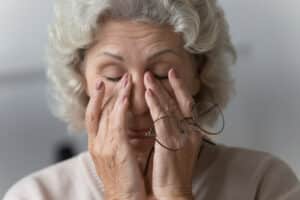
The Link Between Aging and Dry Eye
Your eye’s surface depends on a stable, multi-layered tear film to stay healthy. As you get older, several biological changes make this balance harder to maintain:
- Meibomian gland dysfunction (MGD) becomes more common, reducing the protective oily layer of tears and allowing rapid evaporation.
- The lacrimal glands often produce less aqueous fluid, decreasing overall tear volume.
- The mucin layer, which helps tears spread evenly across the eye, also thins with age.
These changes lead to the classic symptoms of dry eye: a burning or gritty sensation, light sensitivity, blurred vision, and increased eye fatigue.
Risk Factors That Intensify with Age
In addition to natural tear film decline, several common age-related factors can worsen dry eye, including:
- Use of medications such as diuretics, antihistamines, and antidepressants
- Hormonal changes, especially after menopause
- Chronic conditions like diabetes, arthritis, and thyroid disease
- Decreased blink rate and structural eyelid changes
Without treatment, chronic dry eye can eventually damage the corneal surface and impact quality of life.
Proven Strategies for Relief
Dr. Croley provides targeted, in-office and prescription-based treatments to address the root causes of dry eye. Depending on the severity and source of your condition, treatment options may include:
- Punctal plugs to help conserve natural tears by blocking tear drainage
- Tear-stimulating medications that encourage your eyes to produce more tears
- Prescription cyclosporine drops to reduce inflammation and improve tear production
- Antibiotics, when meibomian gland inflammation or blepharitis is present
- Gland expression or heat-based therapies to unblock oil glands and improve tear film stability
- Scleral or therapeutic contact lenses, which protect the eye’s surface and retain moisture
- Surgical closure of tear ducts in severe or persistent cases
These interventions are chosen based on a personalized evaluation and may be combined with at-home support, such as supplements like HydroEye, to enhance results.
Your Eye Health Is in Expert Hands
Dr. Croley’s decades of experience, along with advanced diagnostic technology and a commitment to evidence-based care, make Central Florida Eye Institute a trusted destination for dry eye treatment in Ocala.
Contact (352) 237-8400 to request an appointment and get long-lasting relief and expert support for aging eyes.




